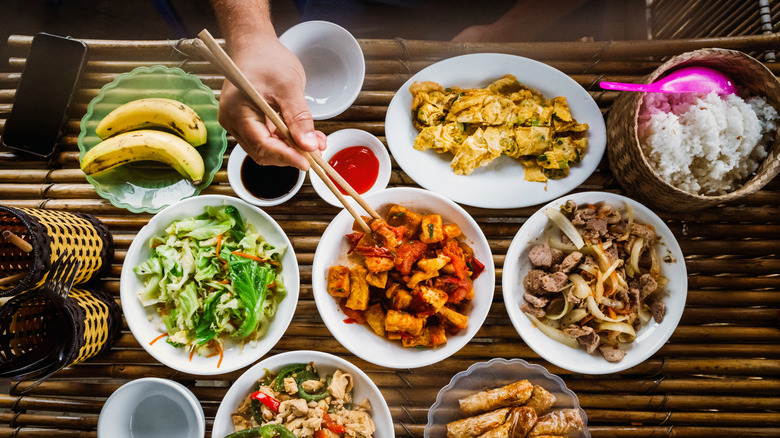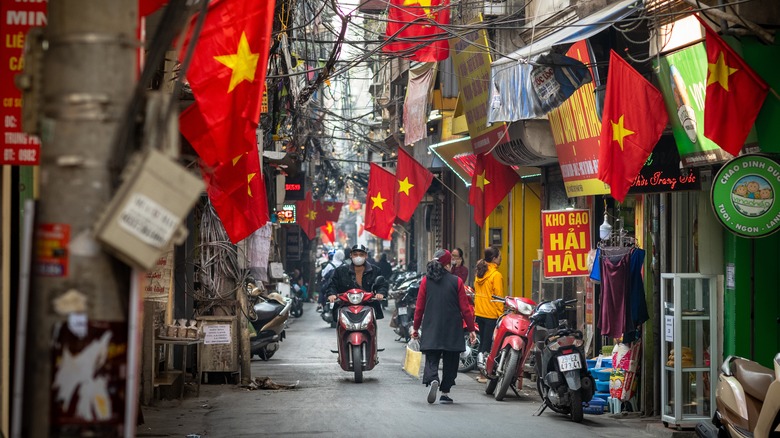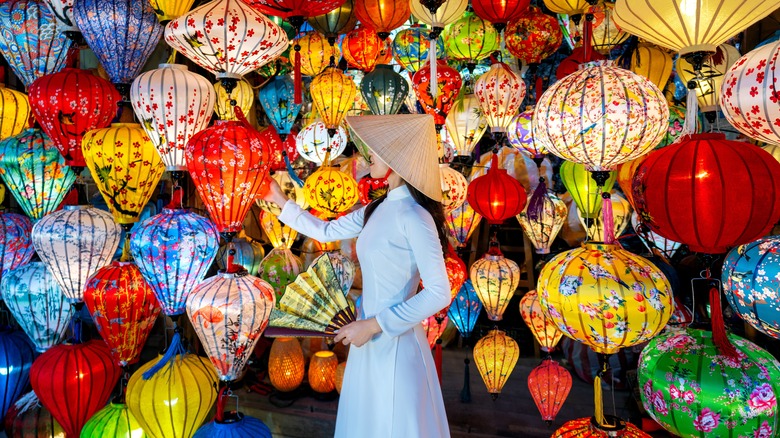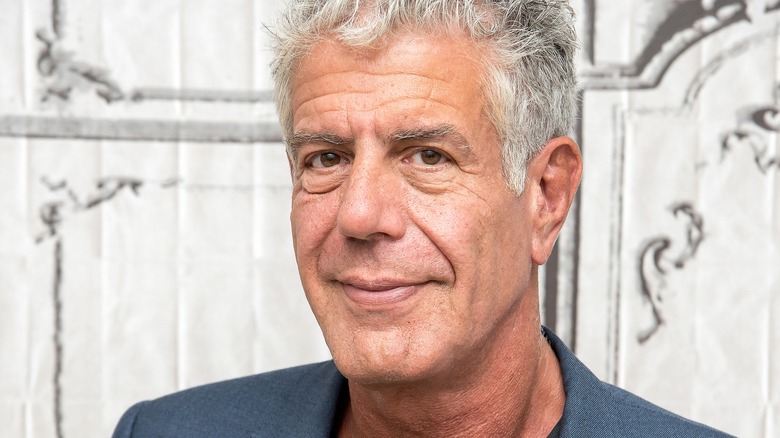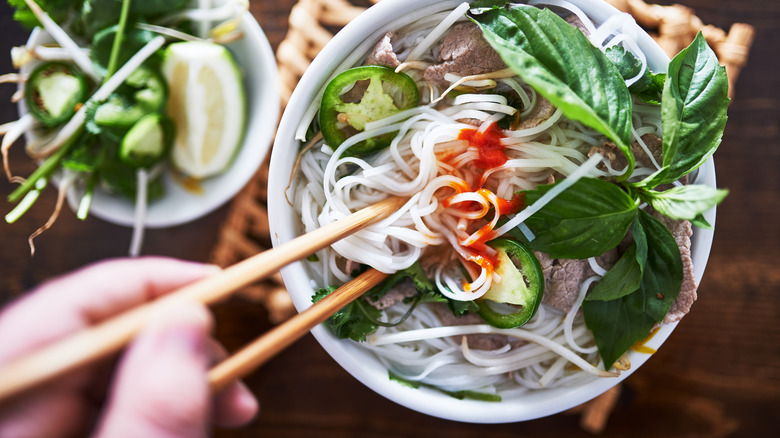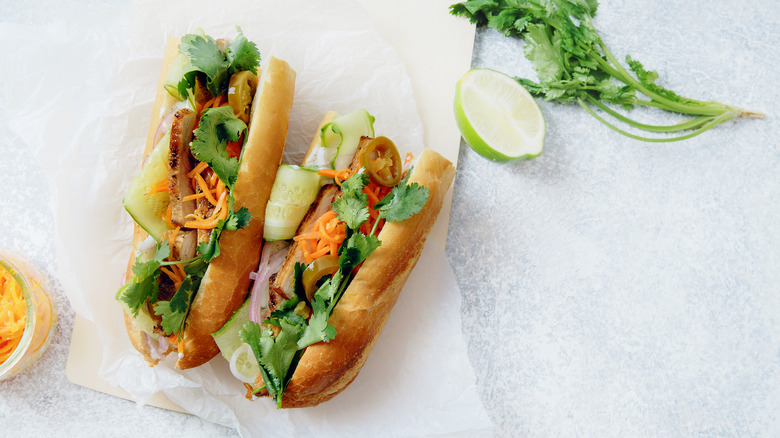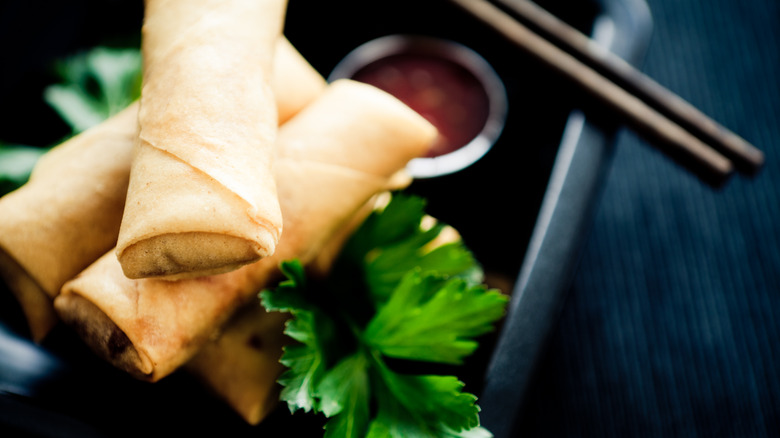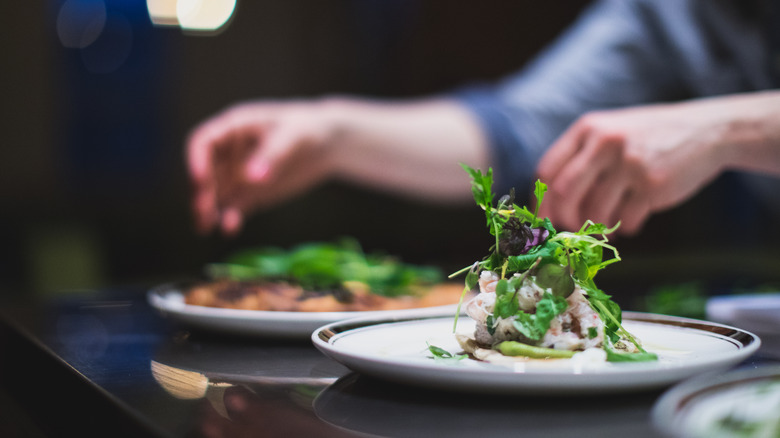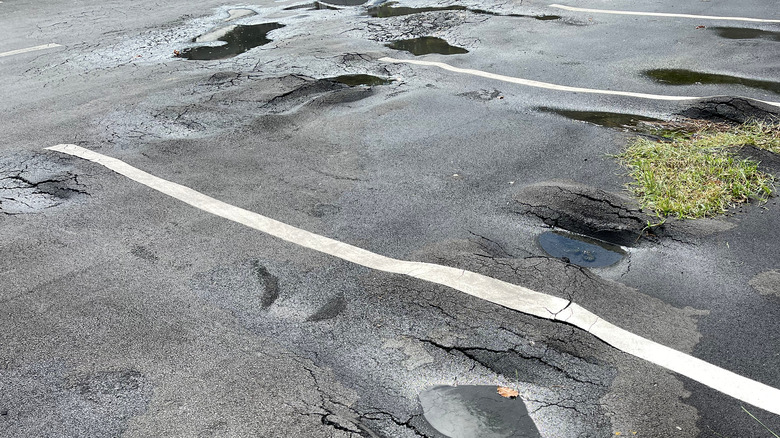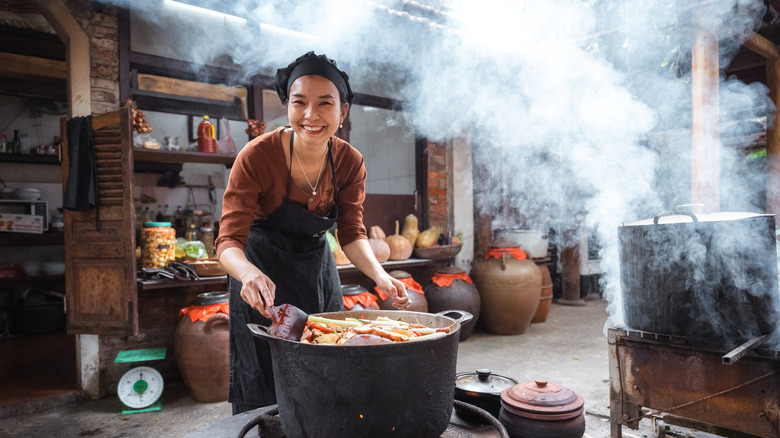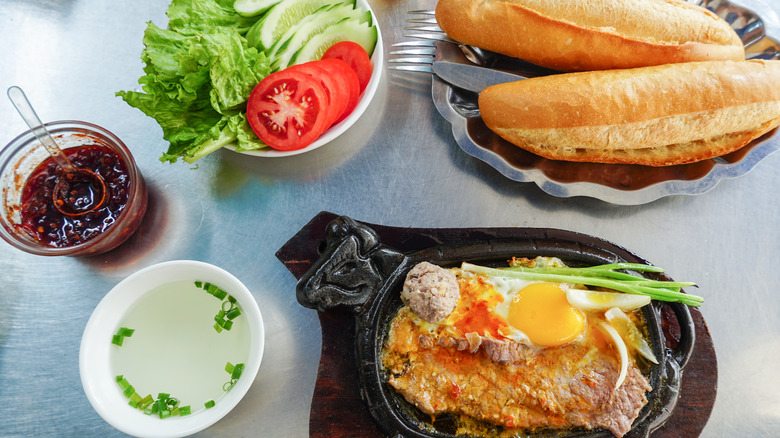Key Tips To Finding Ridiculously Good Vietnamese Restaurants
Vietnamese food is delicious, plain and simple. It's so full of fresh veggies, strong herbs, spicy flavor, and rich broths that even the most decadent dishes feel healthy. Add in fried starters, classic noodle soups, and less mainstream meat such as duck, and you've got yourself a recipe for comfort food, Southeast Asian style. But how do you find the best Vietnamese food? Where do you look? Which sources of information are actually trustworthy? And how can you avoid making mistakes when picking restaurants?
These are the questions any foodie needs answered before picking their next mealtime destination, and this guide is here to help you do just that. Chowhound spoke to several experts in the field of food and travel to get the best insider tips on what makes good Vietnamese food, well, good ... and how to find it. Best of all, while the focus of this article is on helping you discover the best Vietnamese restaurants, you can apply these tips to any genre of food.
Ask a local
When in Rome, do as the Romans do. One of the best ways to find the best restaurants in your area is to ask someone who lives in the city, village, or neighborhood you're exploring what their favorite Vietnamese restaurant is. Try the host of your Airbnb, the guy at the grocery store down the block, or the friend who invited you to town. If you're traveling and have no idea where to start on finding the right restaurant, go to the market and ask some proprietors where they like to go.
One thing you shouldn't do? Ask the tourist board. Tourist boards are typically formed to help local businesses find patrons, not to help travelers find the best products and services. Although good ones do offer such services, chances are good that the one in your destination is just as likely to promote businesses that have paid for advertising. Avoid them if you want to find the best Vietnamese restaurants.
If you don't know anyone in town, don't worry. You can still base your decisions on public opinion, which will give you a better chance of finding the best restaurant: just go where the people go to eat. If you see a busy restaurant and you're ready for lunch, line up and see what happens!
Take the road less traveled
"In general, to find good restaurants, I strive to move past the well-beaten path," Yulia Saf, a travel blogger who has visited more than 70 countries and runs the popular blog Miss Tourist, told Chowhound. "Oftentimes, the true culinary gems are nestled in neighborhoods slightly removed from the city's usual attractions. When it comes to specifically Vietnamese restaurants, I use a similar philosophy, additionally paying attention to the crowd — a busy eatery filled with locals is usually a promising sign."
If you're so new to an area that you don't even know where to start, look up a food tour. Some popular destinations offer food tours of specific areas or that are dedicated to specific cuisines. For instance, in Paris, you can take a food tour of the 5th arrondissement's historical Vietnamese quarter, with all the culture and delicacies associated with it. Once you find a place you love, come back again to try a different dish. This strategy is almost always worth it, as it's both delicious and will deepen your memories of a favorite spot while traveling.
Find out if there's a Little Vietnam
Depending on the town in which you live or to which you're traveling, there may or may not be an area where a lot of Vietnamese locals live. If that's the case, you'll find some ridiculously good Vietnamese restaurants here, often with less pandering to traditional Western flavor palettes.
For instance, while there are some good Vietnamese restaurants in downtown Portland, Oregon, where this writer lives, the best ones are located in the same neighborhoods where the Asian food markets, other Vietnamese restaurants, and locals operate and live. A little research on where the actual community is located can help you zero in on hidden gems.
As Saf points out, "Maintaining an adventurous spirit and willingness to try the lesser-known spots can lead to an unforgettable dining experience, whether you're in Vietnam itself or trying to locate a slice of authentic Vietnamese cuisine in a new city."
Read reviews broadly
Reviews help too, of course. "When it comes to finding good restaurants, I usually rely on online reviews, recommendations from locals, and food-focused social media platforms like Instagram and Yelp," Hammer Tsui shared with Chowhound. She is a professional blogger who lives in Hong Kong and travels the world with her husband and blogging partner on A Fun Couple. "These platforms offer great insights from real diners, allowing me to get an idea of the overall quality and popularity of a restaurant before deciding to try it out."
When reading reviews, check out not only the restaurant's star rating but also the number of reviews it has. The higher the review count, the more consistently it has pleased customers over time. Happily, although fake reviews do still happen, review sites are getting better at tackling spammy or compensated reviews and most have policies regarding how they weed out fake reviews from real ones.
To make doubly sure, read reviews for the restaurant in multiple places, starting with Yelp, TripAdvisor, and Google Reviews. Ritesh Raj, the COO of global accommodation booking platform CuddlyNest, told Chowhound, "When using the internet to find restaurants, remember to read the reviews carefully for insights on the restaurant's strengths and weaknesses. Look for consistent praises or complaints, as they can give you a clearer picture of what to expect."
Look for restaurants on local blogs
"For Vietnamese cuisine specifically, I often seek recommendations from fellow food bloggers and enthusiasts who have a passion for exploring authentic flavors," Tsui explains. "I also pay attention to reviews that highlight the freshness of ingredients, traditional cooking techniques, and the overall ambiance of the restaurant to ensure an authentic dining experience."
Raj advises then zeroing in on the expertise, saying "When traveling, I recommend researching local food blogs and publications in your destination city. They often have up-to-date, insider information on the best places to eat. These sources are often more reliable than generic travel websites as they are usually written by locals who know the city's food scene well."
If a Vietnamese restaurant has made zero appearances in local blogs, then it's either very new or not very good. Almost any establishment will be featured in at least a post or two along the lines of "10 Best Vietnamese Restaurants in Chi-town." When you do find a post, read it carefully to see if the author suggests dishes and gives helpful tips about when to go, where to park, and so forth. If so, they likely went to the restaurant for real, rather than dashed something off in exchange for a check.
Follow chefs and celebrity foodies
If you already spend lots of time on Instagram or X, formerly known as Twitter, consider following celebrity chefs. They love to travel and try new establishments, so you may pick up useful information to help you spot authentic Vietnamese restaurants. Well-known food guides such as Rick Steves or Anthony Bourdain (may he revel in Food Valhalla forever) are also great sources of information on the best dishes and establishments.
Florence Pugh is famously food-obsessed, hence her "Cooking With Flo" YouTube series and the fact that two of the three descriptors in her Instagram bio are food-related. Ed Sheeran is a massive food fan, and Stanley Tucci wrote an entire book on the subject, entitled "Taste: My Life Through Food." In fairness, the all-time Olympic gold medal for celebrity cookbook titles definitely goes to Snoop Dogg and "From Crook To Cook: Platinum Recipes from Tha Boss Dogg's Kitchen."
Point being? Following actors who love grub is another great way to learn interesting recipes and stay on top of up-and-coming restaurants. And since so many of them can afford to travel regularly, they're often in the know.
Look beyond the reviews
"To find good restaurants," Raj explains, "it's essential to look beyond just ratings and reviews. Consider the restaurant's location, the freshness of their ingredients, and their commitment to authentic recipes. A restaurant in a bustling local market, for example, is likely to have access to fresh ingredients. Also, a restaurant that prides itself on using traditional cooking methods is more likely to deliver an authentic experience."
Also, pay attention to the advice to get there early. If online reviews recommend you arrive before the restaurant opens, make a reservation, or come before [insert house specialty] sells out, listen up. That's not only a sign that you need to plan accordingly, but that the restaurant has gotten the ridiculously good seal of approval from an adoring public. If you're in a foreign country and not sure how to make a reservation, ask the concierge at your hotel or the host of your rental for help.
Check for the classics
"At a good Vietnamese restaurant, phở, a fragrant noodle soup with savory broth and tender meat or seafood, is an iconic dish that embodies Vietnamese culinary tradition," Tsui says. "Some other of my personal favorites include banh mi sandwiches, fresh spring rolls, and savory rice." Like spring rolls, Vietnamese summer rolls are another popular choice.
Saf adds that "Some must-try dishes in any good Vietnamese restaurant include bún chả, and bánh xèo. If these aren't on the menu, I'd get suspicious." And Raj weighs in to say that such dishes "offer a taste of the country's diverse flavors. Bánh mì, for instance, combines the crispness of baguette with the richness of pâté and the freshness of pickled vegetables."
You should be just as careful to look for what the restaurant lacks as for what it has. Tsui says, "I would be concerned if a Vietnamese restaurant lacked staple ingredients like fresh herbs, fish sauce, and rice noodles, as these are essential elements in many Vietnamese dishes."
Choose a restaurant with a reasonably sized menu
Menu size matters as well. Long menus are a sign that a restaurant has perhaps not picked a niche, which may mean the food isn't as good. It can also signal that the restaurant keeps a huge range of food types on hand, so some of it may not be as fresh as you'd like.
There is an argument that some menus should be long. For instance, Chinese menus famously have a huge number of choices, a critical component, some contend, in accurately reflecting the country's approach to cuisine and resisting Western cultural assimilation.
Vietnamese restaurants often have long menus as well, again reflecting the number of different choices for rice, noodles, vegetables, broth types, and more. However, if the menu also includes dishes from other cuisines, or dishes of indeterminate origin, be aware that you might not get the classic Vietnamese experience. Caveat emptor.
Check out the prices
It goes without saying that the ideal restaurant is within your budget. If a chef is not specifically purveying a 5-star dining experience, then the restaurant shouldn't have 5-star prices. In tourist trap areas, this is honestly more of a bad sign than a good one, because it indicates that the restaurant might be geared toward luring in suckers. Look for reasonable prices that reflect the level of dining experience the décor and seating promise.
Miss Tourist says "Regarding pricing, it often isn't a reliable indicator of quality — in my experience, some of the best meals I've had were also the most affordable ones." Tsui agrees, arguing that "pricing can sometimes be an indicator of the quality and ambiance of a restaurant, but it's not always a definitive measure of the dining experience. Some of the best meals I've had have been at hole-in-the-wall establishments with affordable prices, while upscale restaurants may not always deliver on their price tag. Instead of solely focusing on pricing, I prioritize factors like the authenticity of the cuisine, the freshness of ingredients, and the overall dining atmosphere."
Raj adds that the skill in preparation matters as well. Family restaurants often provide meals that are every bit as fantastic as Michelin-starred restaurants. Never shy away from small eateries due to a perceived lack of value related to low prices.
Enjoy the regional flavors of Vietnam
Especially for American eaters, the concept of Vietnamese food can often get pigeonholed. Yes, you should look for classics such as phở or bahn mi, but be aware that Vietnam has a good deal of variation within its borders. As Tsui explains, "Vietnam is a diverse country with distinct culinary traditions influenced by geography, climate, and cultural heritage. From the fragrant dishes of the north to the spicy flavors of the south, each region offers its unique culinary delights worth exploring."
This variation is reflected in Vietnam's global cuisine. Accordingly, advises Raj, don't just stick to one kind of Vietnamese food. Instead, "look for places that offer a wide range of dishes from different regions of Vietnam. A good sign is a menu that includes both well-known dishes like phở and lesser-known regional specialties. This shows that the restaurant is knowledgeable about Vietnamese cuisine and is not just catering to popular tastes." If you can find several favorites and several dishes you don't recognize at all, you're on the right track.
Approach fusion cautiously
There's no rule that Vietnamese fusion can't count as a good Vietnamese restaurant. It may be harder to tell whether a restaurant adequately represents the cuisine you're looking to enjoy, but the menu should clue you in somewhat. On the upside, because fusion food can incorporate the techniques, ingredients, and spice palettes of many places, you might experience something you never would have otherwise. And novelty is sometimes a ridiculously good thing.
As Raj says, fusion is "a creative exploration of the cuisine and can be a delightful culinary experience if done right." However, that's only true if the restaurant maintains "the essence of Vietnamese flavors," he cautions. For this reason, Tsui says, "I prefer to visit restaurants that specialize in traditional Vietnamese fare. While fusion restaurants may offer creative interpretations of Vietnamese dishes, they may not always capture the essence and authenticity of the cuisine."
Foodies who have a lot of time and money to spend exploring different restaurants needn't concern themselves with the possible dangers of missing out on the "true" Vietnamese experience. But if you can't eat out very often, whether for budgetary reasons or due to time constraints, at home or abroad, consider going traditional.
Avoid unkempt establishments
No, you shouldn't bug out of a Vietnamese restaurant simply because the décor is lackluster or the feng shui is off. Some of the best eating involves a lot of weird lighting and bruises to the hip bone. However, if the parking lot is overgrown with weeds, the floors or windows are dirty, or the food cases hold wilted displays, exit. Such lack of care will likely extend to the food ... or even the food safety.
Plus, says Saf, "One thing worth mentioning is the significance of appreciating the restaurant's ambiance and staff's hospitality along with the food — these factors play a substantial role in creating an authentic, enjoyable dining experience." Other bad signs include weird confusing schemes, bummed-out staff, funny smells, and a chaotic-looking kitchen.
Take your cue from the food especially. "Authentic Vietnamese restaurants usually place a strong emphasis on fresh herbs and vegetables," Raj says. "If these elements are missing or don't seem fresh, it could be a red flag. Vietnamese cuisine is known for its balance of flavors and its use of fresh herbs and vegetables, so their absence could indicate a compromise on authenticity."
Pay attention to custom
Custom also matters, especially in many Asian cultures that would be considered highly formal by American and other Western standards. Raj doesn't think it's possible to overstate "the importance of understanding local dining customs and etiquette, which can significantly enhance your dining experience and show respect for the local culture. For example, in Vietnam, it's customary to say "Mời bạn ăn" (I invite you to eat) before starting a meal as a sign of respect and hospitality. Knowing such customs can enrich your dining experience."
In America, feel free to strike up a conversation with diners near your table or with people as they're exiting the restaurant, as they may hold the secret to other good Vietnamese restaurants in the area. Of course, use common sense and decorum when doing so, but there's nothing wrong with trying to make friends. In other countries, ask a local what the best etiquette is for talking to strangers in restaurants.
Vietnamese for breakfast? It's a thing
Most Westerners unfamiliar with Vietnamese cuisine unthinkingly forget about breakfast. Partly this is because in Western culture we associate noodles, sandwiches, and meat or veggie dishes with lunch and dinnertime fare. Partly it's because the majority of Vietnamese restaurants don't open until around 11 a.m. in the United States. This is a chicken-or-egg situation that has left Americans without good representations of good Vietnamese breakfasts, but that's not the case in much of the world.
Indeed, Vietnamese breakfasts are delicious. One thing you may not know is that phở, a classic lunch or dinner choice for many Western diners, is frequently eaten as a breakfast food in Vietnam. Bahn mi is another breakfast classic, as is bò né, Vietnam's answer to steak and eggs. Served with tomatoes, eggs, pâté, and crusty Vietnamese baguettes for soaking up the juices, it's like a Southeast Asian Irish breakfast, and it will keep you full for a very long time. Have a long day of hoofing it planned for your vacation? You can't go wrong with bò né.
